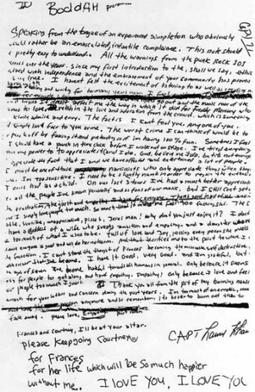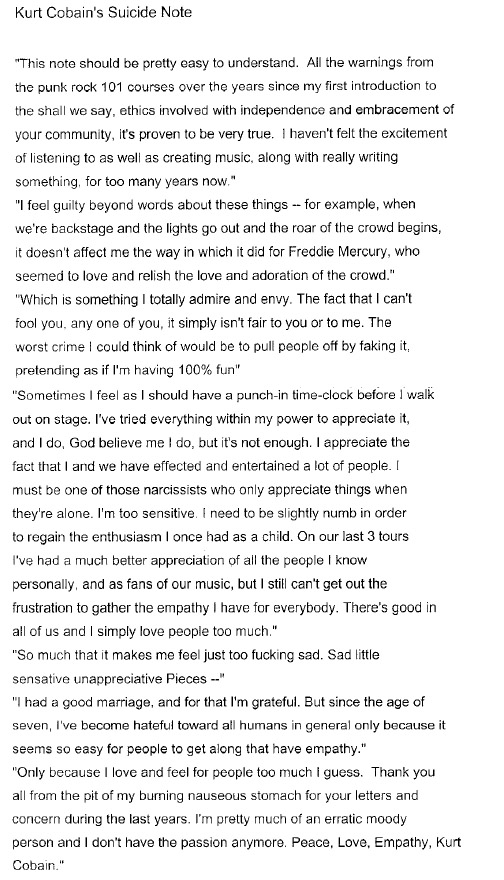We
know a lot about the man Kurt Cobain. We know about his childhood, his life, and
we know about the physical problems that pained him since his adolescence. We
know his music and that is certainly illuminating, but it is one aspect of the
artist’s life that now, in retrospect, seems to be the clearest lens with which
we can view his life, his art, and his death.
On April 8th, 1994,
Seattle PD found Kurt Cobain dead in his greenhouse from an apparently self-inflicted
shotgun would to the head. He left a note reading, 



Some
speculate that this note, however, was only partially written by Kurt Cobain.
The note is clearly written in two different types of handwriting which may
suggest the latter section was not written by Kurt. On the other hand, though,
Kurt Cobain was also severely intoxicated with heroine at the time, having an
insanely high blood content especially considering his small stature. Clearly,
it comes as no surprise that the last section, most likely written while Cobain
was intoxicated and probably just before he killed himself, has a different
handwriting style than the former section. Still, the theory that it wasn’t him
is still evident in that the first and primary portion of the suicide note
doesn’t actually mention dying, it could simply be his resignation from the
music industry.
The
only major evidence within the note that is contrary to this is the final lines
of the first section, “it’s better to burn out than to fade away,” a direct
quote from Neil Young’s song, Hey Hey, My
My (Into the Black). Other than that, though, the direct suicide references
exist only in the messy latter part. While these comments are only directly
written in the latter part of his note, though, they are scribbled all over the
artist’s lyrics, diaries and even interviews.
More interesting than the speculation of his death is the actual effect it had; how his suicide now colors his work and art. Kurt’s music has always been painted in dark colors, but after his death people began looking back at his music and lyrics with a new mindset.
More interesting than the speculation of his death is the actual effect it had; how his suicide now colors his work and art. Kurt’s music has always been painted in dark colors, but after his death people began looking back at his music and lyrics with a new mindset.
“Look
on the bright side, suicide/ Lost eyesight, I’m on your side/Angel, left wing,
right wing, broken wing/ Lack of iron and/or sleeping,” Cobain screams,
confronting the idea of suicide head on and directly in the song, Milk It. The entire song is about the
depression Kurt Cobain harbors inside of himself, but when he yells these four
lines, an entirely new idea emerges. Perhaps it is only now that we can see
Cobain’s intentions in the lyrics, but maybe it is rather that in the light of
his suicide, the true authenticity of his lyrics comes to light. “Look on the
bright side,” Cobain says, confronting suicide directly; “Lost eyesight, I’m on
your/[suicides] side.” Here, Cobain seems to be saying that he’s lost sight of
his ambition and needs. He feels broken, and he is literally contemplating the
bright side of suicide, in his case it seems to be release. Without Cobain’s
suicide, though, these lyrics seem to be Cobain simply flirting with the idea.
It is all too apparent now how all encompassing the negative aspects of his
life were, though.
In another song, Scentless Apprentice, Cobain yells out
as he closes his song, “You can’t fire me because I quit/ Throw me in the fire
and I won’t throw a fit!” A common theme in Kurt’s work was how he has been
abused by the music industry and media, but here Cobain clearly and viscerally
states his deepest feelings about it. As he says in his note, “I
haven't felt the excitement of listening to as well as creating music along
with reading and writing for too many years now;” Kurt lost his love for his
work, but here in his song he out rightly says he would rather die than keep on
obeying and following the life he has been thrown into.
Perhaps Cobain’s most explicit
references to suicide come from the haunting song, Pennyroyal Tea, though. The
entire song is dripped in thoughts of death, and in his lyrics, in the same way
that his note does, describes why – what is was that made him think so deeply
about death. It was just a song, however, and a vague one at that, and no one
seemed to take Kurt’s words to heart until after it was too late. Perhaps,
though, it is only now that we can truly see the implications.
Pennyroyal Tea, a drink used a long
time ago that Kurt Cobain grabbed the song title from, was once used to cause
abortions in pregnant women. It didn’t work, however, and instead only resulted
in severe stomach pain. While Kurt Cobain probably never actually drank
Pennyroyal tea, he did suffer from sever stomach and back pains all his life.
They would even become the reason the young artist first took to drugs. In the
song, however, Kurt Cobain uses Pennyroyal tea as a metaphor, saying he could
drink Pennyroyal Tea all day and it still wouldn’t compare to his own stomach
pains. Dark lyrics undoubtedly, but they are also what draws the song together,
painting a picture of Kurt Cobain’s intensely disturbed interactions with the
world.
The
song in its entirety is basically Kurt Cobain describing how he lives his life
and the constant pain he feels. “I’m on my time with everyone,” Cobain sings to
open the song, and with that lyric he sets the stage: he can’t stand the world
or his interactions with it; he is literally on his edge with everyone he
meets. He is “anemic royalty,” he says
over and over again. He is successful and rich, but he is still sick. His
‘fortunes’ haven’t brought him any satisfaction, and he is simply left anemic
royalty. When he says, “I’m on warm milk and laxatives/ Cherry-flavored
antacids,” however, Kurt Cobain reveals a startling thing about himself, but
what is more startling is how he treats it.
When Kurt Cobain says “warm milk and laxatives,” he is using a metaphor
for heroine and the other drugs he used to sooth his pain. He says, “I’m on,”
to illuminate this, but buries the true medicine he was using in pleasant home
remedies. In this way Cobain seems to almost make light of his problem, or
perhaps the severity of the drug. Either way, though, whether it is his
treatment of his drug problem or how casually he describes, this lyric far more
than unsettling. The drug habit for him began as a remedy for him to escape the
constant pain he was in. In his own words, though, “I just thought, if I’m going
to die, if I’m going to kill myself, I should just take some drugs.”
Kurt Cobain’s story is an extremely
sad one. At the age of seven his parents divorced, and the young artist’s
childhood seemed to shatter with it. He grew up in and out of his parents
houses and living homeless under bridges or on the street. It was at this time
that his stomach pain reached a sort of peak, and with it the artist began
using heroine. Even when Kurt Cobain finally grew up and became successful the
sad story didn’t end; the artist became a target of the media and a type of
pawn for the music industry. “The sad little, sensitive, unappreciative,
Pisces, Jesus man” was thrust into a world where he had lost his privacy, and
everything that he hated about himself was thrown directly into his face.
Cobain found a love and had a baby and for a time that seemed to console him,
but it also seemed to tear him up.
“Throw
back your umbilical noose so I can climb right back,” Kurt Cobain sings in his
song, Heart Shaped Box, talking about
how terrifying the idea of having a baby was for him. Frances, his daughter,
may have made him happy, but it without a doubt also terrified him deep down,
as he ends his suicide note with the words, “Frances and Courtney, I’ll be at
your alter. Please keep going Courtney, for Frances. For her life, which will
be so much happier without me.” As I said before, Kurt Cobain’s life is a sad
one, but what is almost more sad is how many of his direct statements about his
depression and suicidal tendencies were ignored or unnoticed until it was too
late. Still, with the artists suicide now more than twenty years old, the
artist’s work is still well known and influential, and while his death may have
ended his career, it also seems to have allowed him to become the cult figure
and cultural icon he is today. As Neil Young sings in Hey Hey, My My (Into the Black), “the king is gone but he’s not
forgotten.”
Bibliography
1. Fricke, David. “Heart-Shaped Noise. (Cover Story).” Rolling Stone 683 (1994): 63. Academic Search Premier. Web. 17 Apr.
2014
2. Gilmore, Mikal, and Tobias Perse. “The Road From Nowhere.
(Cover Story).” Rolling Stone 683 (1994): 44. Academic Search Premier. Web. 17 Apr. 2014
3. Gold, Todd, Alexis Chiu, and Mary Green. “Remembering Kurt.” People 61.14 (2004): 230-232. Academic Search Premier. Web. 17 Apr.
2014
4. Strauss, Neil, and Alex Foege. “The Downward Spiral. (Cover
Story).” Rolling Stones 683 (1994): 35. Academic Search Premier. Web. 17 Apr. 2014
No comments:
Post a Comment